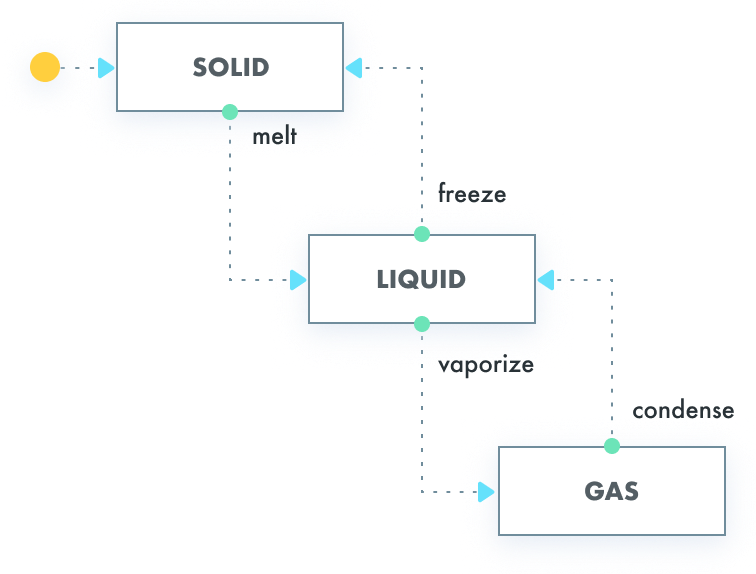A state machine library in Kotlin and Swift.
StateMachine is used in Scarlet
The examples below create a StateMachine from the following state diagram for matter:
Define states, events and side effects:
sealed class State {
object Solid : State()
object Liquid : State()
object Gas : State()
}
sealed class Event {
object OnMelted : Event()
object OnFroze : Event()
object OnVaporized : Event()
object OnCondensed : Event()
}
sealed class SideEffect {
object LogMelted : SideEffect()
object LogFrozen : SideEffect()
object LogVaporized : SideEffect()
object LogCondensed : SideEffect()
}Initialize state machine and declare state transitions:
val stateMachine = StateMachine.create<State, Event, SideEffect> {
initialState(State.Solid)
state<State.Solid> {
on<Event.OnMelted> {
transitionTo(State.Liquid, SideEffect.LogMelted)
}
}
state<State.Liquid> {
on<Event.OnFroze> {
transitionTo(State.Solid, SideEffect.LogFrozen)
}
on<Event.OnVaporized> {
transitionTo(State.Gas, SideEffect.LogVaporized)
}
}
state<State.Gas> {
on<Event.OnCondensed> {
transitionTo(State.Liquid, SideEffect.LogCondensed)
}
}
onTransition {
val validTransition = it as? StateMachine.Transition.Valid ?: return@onTransition
when (validTransition.sideEffect) {
SideEffect.LogMelted -> logger.log(ON_MELTED_MESSAGE)
SideEffect.LogFrozen -> logger.log(ON_FROZEN_MESSAGE)
SideEffect.LogVaporized -> logger.log(ON_VAPORIZED_MESSAGE)
SideEffect.LogCondensed -> logger.log(ON_CONDENSED_MESSAGE)
}
}
}Perform state transitions:
assertThat(stateMachine.state).isEqualTo(Solid)
// When
val transition = stateMachine.transition(OnMelted)
// Then
assertThat(stateMachine.state).isEqualTo(Liquid)
assertThat(transition).isEqualTo(
StateMachine.Transition.Valid(Solid, OnMelted, Liquid, LogMelted)
)
then(logger).should().log(ON_MELTED_MESSAGE)Adopt StateMachineBuilder to gain access to the DSL builder methods:
class MyExample: StateMachineBuilder {
... state machine implementation ...
}Define states, events and side effects:
@StateMachineHashable
enum State {
case solid, liquid, gas
}
@StateMachineHashable
enum Event {
case melt, freeze, vaporize, condense
}
enum SideEffect {
case logMelted, logFrozen, logVaporized, logCondensed
}Initialize state machine and declare state transitions:
let stateMachine = StateMachine<State, Event, SideEffect> {
initialState(.solid)
state(.solid) {
on(.melt) {
transition(to: .liquid, emit: .logMelted)
}
}
state(.liquid) {
on(.freeze) {
transition(to: .solid, emit: .logFrozen)
}
on(.vaporize) {
transition(to: .gas, emit: .logVaporized)
}
}
state(.gas) {
on(.condense) {
transition(to: .liquid, emit: .logCondensed)
}
}
onTransition {
guard case let .success(transition) = $0, let sideEffect = transition.sideEffect else { return }
switch sideEffect {
case .logMelted: logger.log(Message.melted)
case .logFrozen: logger.log(Message.frozen)
case .logVaporized: logger.log(Message.vaporized)
case .logCondensed: logger.log(Message.condensed)
}
}
}Perform state transitions:
expect(stateMachine.state).to(equal(.solid))
// When
let transition = try stateMachine.transition(.melt)
// Then
expect(stateMachine.state).to(equal(.liquid))
expect(transition).to(equal(
StateMachine.Transition.Valid(fromState: .solid, event: .melt, toState: .liquid, sideEffect: .logMelted))
)
expect(logger).to(log(Message.melted))Expand
This information is only applicable to Swift versions older than 5.9:
Due to Swift enumerations (as opposed to sealed classes in Kotlin), any
StateorEventenumeration defined with associated values will require boilerplate implementation forStateMachineHashableconformance.The easiest way to create this boilerplate is by using the Sourcery Swift code generator along with the AutoStateMachineHashable stencil template provided in this repository. Once the codegen is setup and configured, adopt
AutoStateMachineHashableinstead ofStateMachineHashablefor theStateand/orEventenumerations.
StateMachine is available in Maven Central.
Snapshots of the development version are available in Sonatype's snapshots repository.
<dependency>
<groupId>com.tinder.statemachine</groupId>
<artifactId>statemachine</artifactId>
<version>0.3.0</version>
</dependency>implementation 'com.tinder.statemachine:statemachine:0.3.0'.package(url: "https://github.com/Tinder/StateMachine.git", from: "0.3.0")
pod 'StateMachine', :git => 'https://github.com/Tinder/StateMachine.git'
A composable pattern for pure state machines with effects - Andy Matuschak
Thanks to @nvinayshetty, you can visualize your state machines right in the IDE using the State Arts Intellij plugin.
Copyright (c) 2018, Match Group, LLC
All rights reserved.
Redistribution and use in source and binary forms, with or without
modification, are permitted provided that the following conditions are met:
* Redistributions of source code must retain the above copyright
notice, this list of conditions and the following disclaimer.
* Redistributions in binary form must reproduce the above copyright
notice, this list of conditions and the following disclaimer in the
documentation and/or other materials provided with the distribution.
* Neither the name of Match Group, LLC nor the names of its contributors
may be used to endorse or promote products derived from this software
without specific prior written permission.
THIS SOFTWARE IS PROVIDED BY THE COPYRIGHT HOLDERS AND CONTRIBUTORS "AS IS" AND
ANY EXPRESS OR IMPLIED WARRANTIES, INCLUDING, BUT NOT LIMITED TO, THE IMPLIED
WARRANTIES OF MERCHANTABILITY AND FITNESS FOR A PARTICULAR PURPOSE ARE
DISCLAIMED. IN NO EVENT SHALL MATCH GROUP, LLC BE LIABLE FOR ANY
DIRECT, INDIRECT, INCIDENTAL, SPECIAL, EXEMPLARY, OR CONSEQUENTIAL DAMAGES
(INCLUDING, BUT NOT LIMITED TO, PROCUREMENT OF SUBSTITUTE GOODS OR SERVICES;
LOSS OF USE, DATA, OR PROFITS; OR BUSINESS INTERRUPTION) HOWEVER CAUSED AND
ON ANY THEORY OF LIABILITY, WHETHER IN CONTRACT, STRICT LIABILITY, OR TORT
(INCLUDING NEGLIGENCE OR OTHERWISE) ARISING IN ANY WAY OUT OF THE USE OF THIS
SOFTWARE, EVEN IF ADVISED OF THE POSSIBILITY OF SUCH DAMAGE.
